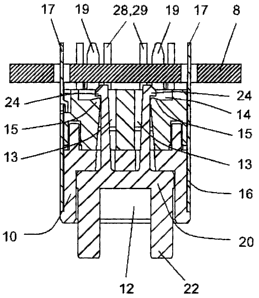Some of the information on this Web page has been provided by external sources. The Government of Canada is not responsible for the accuracy, reliability or currency of the information supplied by external sources. Users wishing to rely upon this information should consult directly with the source of the information. Content provided by external sources is not subject to official languages, privacy and accessibility requirements.
Any discrepancies in the text and image of the Claims and Abstract are due to differing posting times. Text of the Claims and Abstract are posted:
| (12) Patent: | (11) CA 2621722 |
|---|---|
| (54) English Title: | ENCODING DEVICE FOR CONNECTORS |
| (54) French Title: | APPAREIL DE CODAGE POUR CONNECTEURS |
| Status: | Granted |
| (51) International Patent Classification (IPC): |
|
|---|---|
| (72) Inventors : |
|
| (73) Owners : |
|
| (71) Applicants : |
|
| (74) Agent: | BORDEN LADNER GERVAIS LLP |
| (74) Associate agent: | |
| (45) Issued: | 2012-06-12 |
| (22) Filed Date: | 2008-02-15 |
| (41) Open to Public Inspection: | 2008-08-15 |
| Examination requested: | 2008-02-15 |
| Availability of licence: | N/A |
| (25) Language of filing: | English |
| Patent Cooperation Treaty (PCT): | No |
|---|
| (30) Application Priority Data: | ||||||
|---|---|---|---|---|---|---|
|
In order to realize a non-interchangeable mating of two connectors (1, 2), an encoding is provided on the mating side which is realized in the form of lami-nar encoding elements (20) that can be inserted into a slot (12) in the con-nector body (10) of the connectors. In this case, an encoding element (20, 20') that features mutually engaging structures (22, 22) for realizing an encodable mating is inserted into each of the connectors (1, 2).
Afin de réaliser l'appariement non interchangeable de deux connecteurs (1, 2), un codage est réalisé du côté appariement, sous la forme d'éléments de codage laminaires (20) insérables dans une fente (12) du corps des connecteurs (10). Dans ce cas, un élément de codage (20, 20') caractérisé par des structures à engagement mutuel (22, 22), qui permettent de réaliser un appariement codable, est inséré dans chacun des connecteurs (1, 2).
Note: Claims are shown in the official language in which they were submitted.
Note: Descriptions are shown in the official language in which they were submitted.

For a clearer understanding of the status of the application/patent presented on this page, the site Disclaimer , as well as the definitions for Patent , Administrative Status , Maintenance Fee and Payment History should be consulted.
| Title | Date |
|---|---|
| Forecasted Issue Date | 2012-06-12 |
| (22) Filed | 2008-02-15 |
| Examination Requested | 2008-02-15 |
| (41) Open to Public Inspection | 2008-08-15 |
| (45) Issued | 2012-06-12 |
There is no abandonment history.
Last Payment of $624.00 was received on 2024-02-06
Upcoming maintenance fee amounts
| Description | Date | Amount |
|---|---|---|
| Next Payment if standard fee | 2025-02-17 | $624.00 |
| Next Payment if small entity fee | 2025-02-17 | $253.00 |
Note : If the full payment has not been received on or before the date indicated, a further fee may be required which may be one of the following
Patent fees are adjusted on the 1st of January every year. The amounts above are the current amounts if received by December 31 of the current year.
Please refer to the CIPO
Patent Fees
web page to see all current fee amounts.
| Fee Type | Anniversary Year | Due Date | Amount Paid | Paid Date |
|---|---|---|---|---|
| Request for Examination | $800.00 | 2008-02-15 | ||
| Application Fee | $400.00 | 2008-02-15 | ||
| Section 8 Correction | $200.00 | 2008-08-20 | ||
| Maintenance Fee - Application - New Act | 2 | 2010-02-15 | $100.00 | 2010-01-08 |
| Maintenance Fee - Application - New Act | 3 | 2011-02-15 | $100.00 | 2010-12-16 |
| Maintenance Fee - Application - New Act | 4 | 2012-02-15 | $100.00 | 2011-12-13 |
| Final Fee | $300.00 | 2012-03-30 | ||
| Maintenance Fee - Patent - New Act | 5 | 2013-02-15 | $200.00 | 2013-01-25 |
| Maintenance Fee - Patent - New Act | 6 | 2014-02-17 | $200.00 | 2014-01-08 |
| Maintenance Fee - Patent - New Act | 7 | 2015-02-16 | $200.00 | 2015-01-21 |
| Maintenance Fee - Patent - New Act | 8 | 2016-02-15 | $200.00 | 2016-01-20 |
| Maintenance Fee - Patent - New Act | 9 | 2017-02-15 | $200.00 | 2017-01-25 |
| Maintenance Fee - Patent - New Act | 10 | 2018-02-15 | $250.00 | 2018-02-02 |
| Maintenance Fee - Patent - New Act | 11 | 2019-02-15 | $250.00 | 2019-02-01 |
| Maintenance Fee - Patent - New Act | 12 | 2020-02-17 | $250.00 | 2020-02-07 |
| Maintenance Fee - Patent - New Act | 13 | 2021-02-15 | $255.00 | 2021-02-01 |
| Maintenance Fee - Patent - New Act | 14 | 2022-02-15 | $254.49 | 2022-02-01 |
| Maintenance Fee - Patent - New Act | 15 | 2023-02-15 | $473.65 | 2023-02-01 |
| Maintenance Fee - Patent - New Act | 16 | 2024-02-15 | $624.00 | 2024-02-06 |
Note: Records showing the ownership history in alphabetical order.
| Current Owners on Record |
|---|
| HARTING ELECTRIC GMBH & CO. KG |
| Past Owners on Record |
|---|
| DE VANSSAY, JEAN-MERRI |
| MERMAZ, ALEXANDRE |